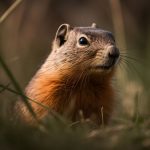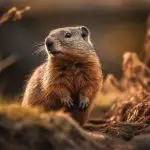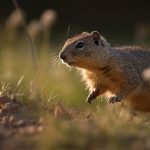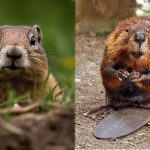Is A Gopher A Rodent? – (Everything You Need To Know!)
Are gophers rodents? Yes, gophers, commonly known as pocket gophers, are rodents of the Geomyidae family. Gophers are herbivores and feed on plants, roots and vegetation. They live underground and use their tails for movement guidance and navigation with a backward movement.
Under the kingdom Animalia and the Rodentia order of classification, Gophers are further classified into six genera and approximately 35 species according to animal behavior. Key genera include Cratogeomys, Geomys, Orthogeomys, Pappogeomys, Thomomys, and Zygogeomys. Gophers are classified based on the following;
- Size of the forefeet
- Size of the claws
- Color of the fur
- Number of grooves on the upper front incisors
- Body length
Is a gopher a rodent? This article will give you a comprehensive guide on classifying gophers, their evolutionary history, and their role in ecosystems. In addition, we will look at the characteristics of different genera as used to organize them and their importance to animal taxonomy and wildlife management.
What Is A Rodent?
Rodents, scientifically known as Rodentia. They are small gnawing mammals characterized by continuously growing pairs of incisors in the upper and lower jaws with no canine teeth.
Accordingly, rodents comprise the largest group, with approximately 40% of mammals in the animal kingdom being rodents.
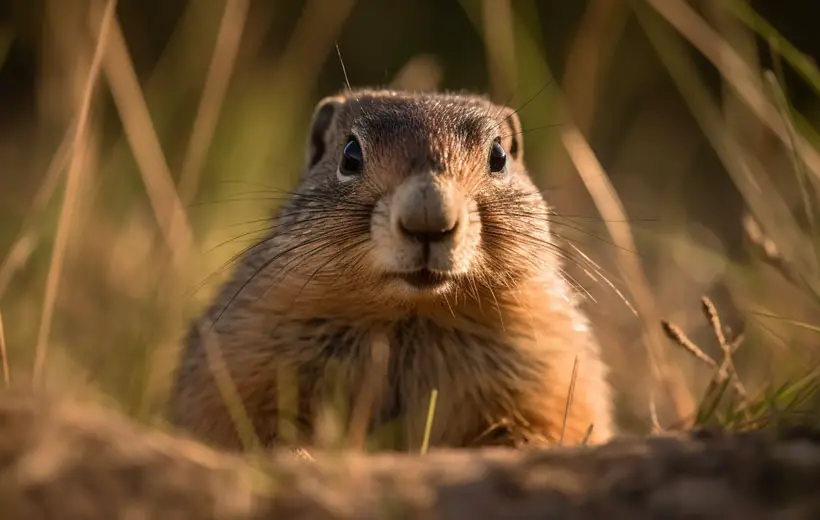
Below is an overview of the Rodentia taxonomic classification table in summary.
| Classification | Group |
|---|---|
| Kingdom | Animalia |
| Phylum | Chordata |
| Sub-phylum | Vertebrata |
| Class | Mammalia |
| Order | Rodentia |
| Sub-order | Castorimorpha |
| Family | Geomyidae |
Under the animal Taxonomy classification, rodents are subdivided into mice, squirrels and cavy-like rodents, each consisting of several species. One key identifier of any rodent is the ever-growing pair of sharp incisors on the upper and lower jaws.
Defining Characteristics Of Rodents And Their Evolutionary History
Gophers trace their evolutionary history to pocket gopher’s fossil remains found in Northern America. According to Encyclopedia Britannica, the fossils were between 28.5 million and 33.7 million years old.

Rodents such as gophers are classified based on their unique animal physiology characteristics. Let’s look at these characteristics below.
- Medium-sized with short, strong feet and sharp claws
- A pair of solid and pointed incisors in each jaw
- Ever-growing incisors due to friction wear
- Thick fur ranging from brown to black
- Sharp and long incisors that do not have enamel and root
- A large diastema behind incisors and no canine teeth
Comparison Of Rodents To Other Animals Within The Animal Kingdom
Rodents such as gophers are distinguished from other animals by their medium-sized bodies covered in a thin layer of fur ranging from brown to black. These animal habitats are underground channels that burrow in search of roots to feed on and for shelter.
Gophers have cheek bags for storing food and other materials required for nesting. The bags extend to the shoulders and are helpful when feeding young ones.
Unlike other animals, rodents such as gophers and their classification have a backward movement in the tunnels where they use their tails to sense.
Their lips can close behind the incisors allowing gophers to excavate soil without ingesting it.
Ecological And Economic Significance Of Rodents
Rodents live underground with few instances of surfacing to search for food and nesting materials. Their lifestyle has a positive and negative impact on the ecosystem.

Let’s look at gophers and their role in the ecosystem.
Most rodents are fossorial, meaning they live underground, destroying land by making channels and heaping soil on top. The soil gets exposed to agents of pollution.
The same activities help improve soil structure through aeration and nutrient cycling, which are essential for crop growth.
The Gopher Family
Within the rodentia classification from the Geomyidae family, gophers are further subdivided into the following genera, each with a distinctive location.

Through evolutionary biology, gophers are subdivided into species in different parts of the world.
- Genus Cratogeomys (Mexican pocket gophers)
- Genus Geomys (eastern pocket gophers)
- Genus Orthogeomys (taltuza)
- Genus Pappogeomys (southern pocket gophers)
- Genus Thomomys (western pocket gophers and northern pocket gophers)
- Genus Zygogeomys
Physical Characteristics Of Gophers And How They Compare To Other Rodents

Despite the wide gopher classification, gophers share much in common with most rodents’ characteristics and physical features. Their physical characteristics are:
- A pair of long sharp incisors in each jaw that provides a proper grip for gnawing and chewing roots and plant materials
- Ever-growing incisors: These incisors regenerate with usage as they wear in the gnawing process. The growth helps keep them sharp and of the correct size
- Incisors tooth without a root and enamel: Enamel contains veins and nerves that would get damaged during wear and tear due to friction when chewing and gnawing
- A diastema right after the incisors: The diastema provides a space for turning and rolling chewed food into balls for easy swallowing
- Gophers have no canines to create the diastema needed for efficient chewing and preparation for food before swallowing
- Strong masculine jawbone: The jaw is vital to support the constant gnawing and chewing of hard plants without breaking
- Baculum penis: Rodents, especially those endangered by wild predators and humans, must reproduce in large numbers to maintain their colony. As such, most rodents have a penis bone to facilitate reproduction
Explanation Of The Different Species Of Gophers And Their Geographic Distribution
Gophers are classified according to various factors and as such different species are distributed in various geographical environments. Each species is adapted best to a specific geographical area as discussed below.
Species from Genus Cratogeomys include C. castanops, C. goldmani, C. fumosus, C. gymnurus, C. merriami, C. neglectus, C. tylorhinus, and C. zinseri. Most of them are distributed in the Southwest United States and Mexico.

From Genus Geomys, we have the following species; G. arenarius, G. attwateri, G. breviceps, G. bursarius, G. knoxjonesi, G. personatus, G. pinetis, G. texensis, G. tropicalis distributed on the northern American great plains.
Genus Orthogeomys species include O. cavator, O. cherriei, O. cuniculus, O. dariensis, O. grandis, O. heterodus, O. hispidus, O. lanius, O. matagalpae, O. thaeleri, and O. underwoodi. They are located in Mexico, Central America and the shores of Costa Rica.
From Genus Pappogeomys, P. bulled species is found distributed in the States of Colima and Nayarit in west-central Mexico.
Genus Thomomys has nine animal species present in SW Canada, the western United States and primarily in Mexico including T. bottae, T. bulbivorus, T. clusius, T. idahoensis, T. mazama, and T. monticola.
The Michoacan gopher and tuza gophers species are distributed in the temperate regions of Mexico
Gophers in Ecosystems
Gophers contribute positively and negatively to the ecosystem role from their life cycle. Since they reproduce in large numbers, their impact is far-reaching if not controlled for the adverse effects.

Positive Effects Of Rodents On The Ecosystem.
By burrowing, rodents help improve the soil structure by allowing for better air circulation. Soil heaped as a result of burrowing. It enables the nutrient cycle through the relocation of dirt from one point to another.
Rodents such as gophers break down soil particles, facilitating soil formation and aeration. The nesting materials, food leftovers and their droppings underground decompose and add humus to the soil.
Negative Impacts On The Ecosystem.
Gophers destroy plant roots as they burrow underground, causing death and wilting of crops. The burrowing act destabilizes soil and exposes soil to agents of soil pollution.
Burrows in the land may act as habitats for dangerous animals such as snakes. Gophers are also considered pests for feeding on crops and cereals on the land.
Overview Of The Interactions Between Gophers And Other Animals Within Their Ecosystems
Gophers in the rodentia family relate well with most non-carnivore animals in their ecosystems. They even shelter other underground animals that cannot burrow, such as snakes and frogs.
On the other hand, gophers face a significant threat from their predators within their ecosystem. Humans and carnivorous animals predate gophers in the wild for food.

Being herbivores, gophers rarely threaten the animal ecology around them. However, human beings consider them harmful pests as they feed on plant roots, leaves, seeds and cereals.
Therefore, gophers remain in a constant hunt by human beings to safeguard their crops.
Explanation Of The Benefits And Drawbacks Of Gopher Populations Within Different Ecosystems
Gophers may have benefits or drawbacks depending on the ecosystem they occupy.
Within lands that are left uncultivated for long seasons, gophers may prove to be of the following benefits.
- Improvement of the soil structure by allowing for efficient soil aeration in the dorman soils
- Addition of humus and assisting in decomposition of the weeds and unnecessary plants
- Soil formation – Gophers’ tunnels help cycle soil from bottom layers to top surface and break into small particles
On the other hand, gopher populations pose the following threats when they occupy arable land which has crops.
- Loss of harvest as they damage crop roots and cereals. Large populations of gophers can cause immense losses if not eradicated in time
- Damage to underground piping and cables. This is seen especially in lands cultivated using drip and underground irrigation systems
- Spread of diseases of such as rabies and hantavirus to humans in case of coming in contact
FAQs
Here are frequently asked questions about gophers-
Q: What Other Animals Are Classified As Rodents?
Rodents make up a vast population of animal families in the kingdom. Other animals, such as rats, hamsters and mice, are considered rodents.
Q: Are Gophers Considered Pests?
Yes. Most Gopher species are considered pests as they feed on crops and seeds considered helpful by humans. Gophers also eat plant roots which may cause significant damage to crops.
Q: What Threats Do Gophers Face In Their Natural Habitats?
Gophers face threats from man’s pest control measures and their key predators, such as snakes, foxes, and weasels, that can follow them into their burrows.
Conclusion
Gophers are burrowing rodents with positive and negative effects on ecosystem dynamics. They have unique features to help them survive in the hostile ecosystem and their feeding and survival habits. Under the animal taxonomy, we have summarized the classification of rodents and gophers in specific.
Gophers have benefits and drawbacks on different ecosystems and how they relate with other animals. Understanding the classification, their ecological role and the evolutionary history of gophers helps in their control in the field.
The information also helps in wildlife management and care for gophers listed as prone to extinction.

